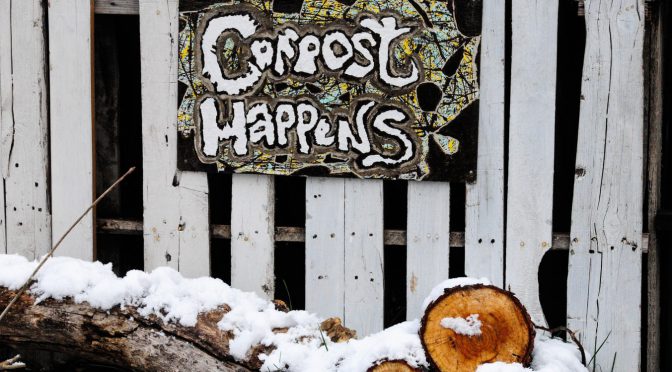Compost is one of the best soil amendments you can use. It enriches the soil and adds structure and beneficial fungi and bacteria. Having healthy soil increases your plants pest and disease resistance and makes your garden more productive. Making your own compost at home is a simple way to save money on garden supplies. It’s also good for the environment, keeping tons of food waste out of landfills each year.
Selecting a Compost Bin
To get started you’ll need a compost bin. Many farms just have large compost piles but this may not be the best option if you live in a neighborhood or have pets that will dig through your compost.
Tumblers
Some folks opt to purchase compost tumblers. These are basically barrels on a stand that allow you to turn your compost without manually doing it with a pitchfork. The down side of these is that they can be pricey and hold a limited amount. They’re great if you’re just adding food scraps but if you have access to a lot of material or keep chickens or other livestock they fill up quickly.
Bins
Compost bins can be purchased or are easy to DIY. Pallets are commonly used to create simple bins. Just remember if your bin is closed on all four sides, it’s best if you can easily remove a side so you can turn your compost. You may also want to consider adding a lid to your bin. This can help keep your compost from getting too dry or too wet.
Multi-Bin Systems
If you opt to build your own bin you might want to consider actually making two or three. That way when your compost in the first bin begins breaking down you can stop adding new material to it and add it to the next bin. This way you have compost in various stages.
Acceptable Materials
Basically there are two categories of materials that you’ll add to your compost bin. These include “brown” or carbon-rich materials and “green” or nitrogen-rich materials.
A basic rule of thumb is that you want to add these brown and green materials in a 1:1 ratio. If your pile is too dry and not breaking down, add more green materials. If you’re pile is too wet, slimy, and smelly add more brown materials.
Brown
- Fallen leaves
- Wood chips, shavings, or sawdust
- Corn stalks
- Pine needles (can make your compost more acidic)
- Shredded paper (avoid glossy material like magazines)
- Straw
- Hay
- Nut shells
- Paper towels (unless they have cleaning chemicals on them)
- Brown cardboard
- Wood ash
Green
- Grass clippings
- Coffee grounds
- Vegetable scraps
- Fruit scraps
- Animal manure (avoid dog and cat)
- Weeds
- Eggs shells
- Seaweed
- Plant clippings
- Tea and tea bags
Things Not to Compost
There are a few things to avoid putting in your compost bin.
- Animal products
Meat, fish, and dairy can cause odor problems and attract pests. They should especially be avoided if you live in a neighborhood. - Fats and oils
Like animal products, these will cause odor and may attract pests. - Diseased or pest-ridden plants
You don’t want to add these problems to your new healthy soil! - Cat and dog poop
These can contain parasites that can be passed to humans handling the compost. - Sawdust from treated lumber
It contains harmful chemicals. - Coal and charcoal ash
It can harm plants. - Treated plant or yard waste.
It can contain harmful pesticides and herbicides that could harm your plants and be unhealthy for you.
Maintaining Compost
Every few weeks you should turn your compost. For those without tumblers, this means flipping your compost pile over using a pitchfork or shovel. This helps aerate your compost and encourages microbes to continue breaking down material. It also means new material doesn’t just sit on top.
Your compost pile will decompose best if it’s moist but not wet. If it has been hot and dry in your area and your compost seems dry you can add a bit of water with your garden hose or watering can. However, if your area has been really rainy you may want to cover your compost if it isn’t in a closed bin.
If your compost has a lot of dry brown materials and isn’t breaking down it’s a good indicator that you need to add more green materials. If it’s slimy, smelly, and not breaking down well you should add more brown material.
Using Your Compost
You can use your compost for a variety of applications. The simplest thing is to spread it over your garden beds. Additionally it can be added to potting soil or homemade potting mix to give your plants a boost. It’s also great for making compost tea which can be used to water plants that need a bit of extra nutrients.

